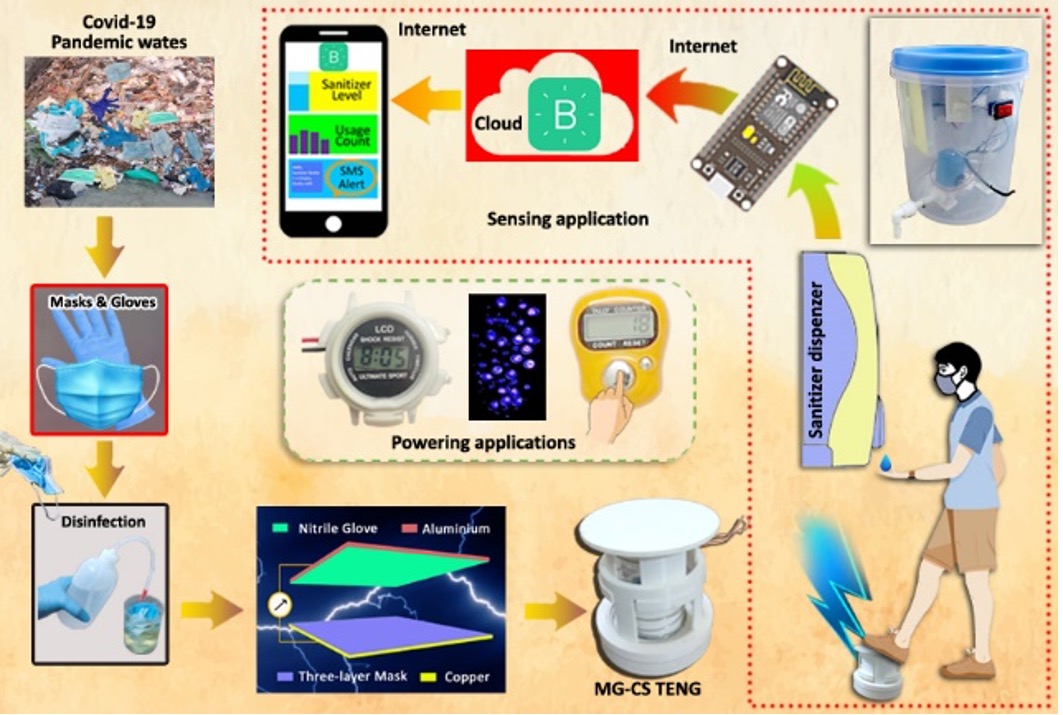| Jan 20, 2023 | |
Recycling COVID-19 clinical wastes towards triboelectric touch sensors for IoT applications |
|
| (Nanowerk Spotlight) The extensive use of polymer-made, disposable and non-biodegradable COVID-19 pandemic health protectives like surgical face masks, hand gloves and PPE kits, combined with a lack of proper waste recycling systems, considerably increased plastic pollution around the world. | |
| Young scientists, Mr. Sayyid Abdul Basith and Dr. Arunkumar Chandrasekhar from the Sensor Systems Lab at Vellore Institute of Technology in India, are harnessing a new way to turn COVID-19 pandemic wastes towards sensor fabrication: The urgent requirement to reduce microplastic environmental pollution motivated them to fabricate a mask-glove-based contact-separation triboelectric nanogenerator (MG-CS TENG). | |
| Reporting their findings in Nano Energy ("COVID-19 clinical waste reuse: A triboelectric touch sensor for IoT-cloud supported smart hand sanitizer dispenser"), first authored by Sayyid Abdul Basith, the two scientists demonstrate a simple, cost-effective, and efficient waste-to-energy conversion approach. The mechanism is based on the principles of contact electrification and electrostatic induction. | |
 |
|
| Schematic illustration shows MG-CS TENG's fabrication from COVID-19 clinical wastes and its powering and sensing applications. (Image courtesy of the researchers) (click on image to enlarge) | |
| The researchers re-used disinfected surgical three-layer face masks and nitrile hand gloves to fabricate their MG-CS TENG. To do so, a piece of a face mask, one side coated with copper, and a piece of a glove, one side coated with aluminum, were placed inside a 3D-printed supporting framework with a metallic spring so the device could press and release to generate electrical signals. | |
| The copper and aluminum act as electrodes to connect with external circuits. A periodic AC voltage and current were obtained across the electrode terminals due to the continuous contact and separation between the mask and gloves. When the MG-CS TENG is in its pressed state, the mask and glove surfaces contact each other and transfer ions between them. | |
| The surface static charge formation or triboelectrification occurs between some particular dissimilar triboelectric materials when they contact each other. | |
| Here, the nitrile gloves become positively charged, and the three-layer mask becomes negatively charged. When they are separated, opposite charges will be induced on the attached electrodes due to electrostatic induction. The potential difference created between the electrodes causes them to flow current through the external circuit. The amount of voltage and current generated depends on the applied mechanical force on the device. | |
| The harvested energy was stored in a capacitor to power electronic devices like digital tally counters, wristwatches, lumex displays, and series-connected 25 LEDs. | |
| The team demonstrated the sensing application of their MG-CS TENG as a pedal-operated touch sensor to dispense hand sanitizer. The setup was integrated using the IoT and Blynk for the remote monitoring and controlling of the sanitizer dispenser using a smartphone. | |
| "Our approach suppresses microplastic environmental pollution and prevents the spread of coronavirus," Basith concludes. | |
| Provided by Nanosensors and Nanoenergy Lab, Vellore Institute of Technology | |
|
Become a Spotlight guest author! Join our large and growing group of guest contributors. Have you just published a scientific paper or have other exciting developments to share with the nanotechnology community? Here is how to publish on nanowerk.com. |
|
